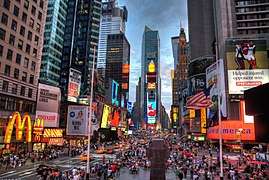Harlem
| Harlem | |
|---|---|
| Neighborhood of Manhattan | |
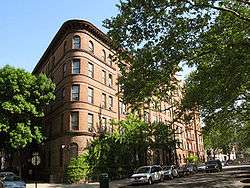 Apartment buildings next to Morningside Park | |
| Nickname(s): "Heaven", "Black mecca" | |
| Motto(s): "Making It!" | |
| Coordinates: 40°48′33″N 73°56′54″W / 40.80917°N 73.94833°WCoordinates: 40°48′33″N 73°56′54″W / 40.80917°N 73.94833°W | |
| Country |
|
| State |
|
| County |
|
| City |
|
| Founded | 1658 |
| Named for | Haarlem, Netherlands |
| Area[1] | |
| • Total | 10.03 km2 (3.871 sq mi) |
| Population (2000)[2][3][4] | |
| • Total | 335,109 |
| • Density | 33,000/km2 (87,000/sq mi) |
| Economics | |
| ZIP Codes | 10026–10027, 10029–10031, 10035, 10037, 10039 |
| Area codes | 212, 332, 646, and 917 |
Harlem is a large neighborhood in the northern section of the New York City borough of Manhattan. Since the 1920s, Harlem has been known as a major African American residential, cultural and business center. Originally a Dutch village, formally organized in 1658,[5] it is named after the city of Haarlem in the Netherlands. Harlem's history has been defined by a series of economic boom-and-bust cycles, with significant population shifts accompanying each cycle.[6]
Following the Civil War, poor Jews and poor Italians were the predominant demographics in Harlem. African-American residents began to arrive in large numbers in 1905 as part of the Great Migration. In the 1920s and 1930s, Central and West Harlem were the focus of the "Harlem Renaissance", an outpouring of artistic work without precedent in the American-black community. However, with job losses during the Great Depression and the deindustrialization of New York City after World War II, rates of crime and poverty increased significantly. Harlem's African-American population peaked in the 1950s.[7] In the second half of the 20th century, Harlem became a major hub of African-American businesses. In 2008, the United States Census found that, for the first time since the 1930s, fewer than half of the residents were black, constituting only 40% of the population.[7]
Since New York City's revival in the late 20th century, Harlem has been experiencing the effects of gentrification and new wealth.
Geography
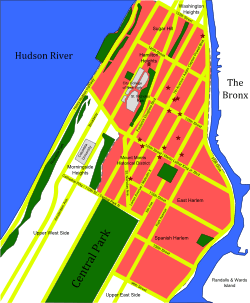
Harlem is located in Upper Manhattan, often referred to as Uptown by locals. It stretches from the Harlem River and East River in the east, to the Hudson River to the west; and between 155th Street in the north, where it meets Washington Heights, and an uneven boundary along the south that runs along either 96th Street east of Fifth Avenue or 110th Street west of Fifth Avenue.
Central Harlem is bounded by Fifth Avenue on the east, Central Park on the south, Morningside Park, St. Nicholas Avenue and Edgecombe Avenue on the west, and the Harlem River on the north.[8] A chain of three large linear parks—Morningside Park, St. Nicholas Park and Jackie Robinson Park—are situated on steeply rising banks and form most of the district's western boundary. On the east, Fifth Avenue and Marcus Garvey Park, also known as Mount Morris Park, separate this area from East Harlem. The bulk of the area falls under Manhattan Community Board No. 10.[2] In the late 2000s, South Harlem, emerged from area redevelopment, running along Frederick Douglass Boulevard from West 110th to West 138th Streets.[9][10]
The West Harlem neighborhoods of Manhattanville and Hamilton Heights comprise part of Manhattan Community Board No. 9. The two neighborhoods' area is bounded by Cathedral Parkway (110th Street) on the South; 155th Street on the North; Manhattan/Morningside Ave/St. Nicholas/Bradhurst/Edgecome Avenues on the East; and Riverside Park/the Hudson River on the west. Manhattanville begins at roughly 123rd Street and extends northward to 135th Street. The northern most section of West Harlem is Hamilton Heights.[3]
East Harlem, also called Spanish Harlem or El Barrio, within Manhattan Community Board 11, is bounded by East 96th Street on the south, East 138th Street on the north, Fifth Avenue on the west, and the Harlem River on the east.[4]
Emergency services and representation
The New York City Police Department patrols six precincts located within Harlem. The areas of West Harlem are served by the 30th Precinct,[11] and the 26th Precinct,[12] the areas of Central Harlem are served by the 28th[13] and 32nd Precincts,[14] and the areas of East Harlem are served by the 23rd[15] and 25th Precincts.[16]
The New York City Fire Department operates nine firehouses in Harlem, organized into two Battalions. The following fire companies are quartered in Harlem: Engine 35, Engine 37, Engine 47, Engine 58, Engine 59, Engine 69, Engine 80, Engine 84, Engine 91, Ladder 14, Ladder 23, Ladder 26, Ladder 28, Ladder 30, Ladder 34, Ladder 40, and the Chiefs of the 12th and 16th Battalions.
Harlem is represented by New York's 13th congressional district, the New York State Senate's 30th district, the New York State Assembly's 68th and 70th districts, and the New York City Council's 7th, 8th, and 9th districts.
History
.tiff.jpg)
Before the arrival of European settlers, the area that would become Harlem (originally Haarlem) was inhabited by the Manhattans, a native tribe, who along with other Native Americans, most likely Lenape[17] occupied the area on a semi-nomadic basis. As many as several hundred farmed the Harlem flatlands.[18] Between 1637 and 1639, a few settlements were established.[19][20] During the American Revolution, the British burned Harlem to the ground.[21] It took a long time to rebuild, as Harlem grew more slowly than the rest of Manhattan during the late 18th century.[22] After the American Civil War, Harlem experienced an economic boom starting in 1868. The neighborhood continued to serve as a refuge for New Yorkers, but increasingly those coming north were poor and Jewish or Italian.[23] The New York and Harlem Railroad,[24] as well as the Interborough Rapid Transit and elevated railway lines,[25] helped Harlem's economic growth, as they connected Harlem to lower and midtown Manhattan.
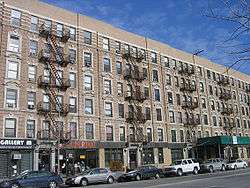
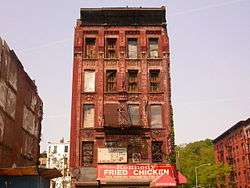
The Jewish and Italian demographic decreased, while the black and Puerto Rican population increased in this time.[26] The early 20th-century Great Migration of blacks to northern industrial cities was fueled by their desire to leave behind the Jim Crow South, seek better jobs and education for their children, and escape a culture of lynching violence; during World War I, expanding industries recruited black laborers to fill new jobs, thinly staffed after the draft began to take young men.[27] In 1910, Central Harlem was about 10% black. By 1930, it had reached 70%.[28] Starting around the time of the end of World War I, Harlem became associated with the New Negro movement, and then the artistic outpouring known as the Harlem Renaissance, which extended to poetry, novels, theater, and the visual arts. So many blacks came that it "threaten[ed] the very existence of some of the leading industries of Georgia, Florida, Tennessee and Alabama."[29] Many settled in Harlem. By 1920, central Harlem was 32.43% black. The 1930 census revealed that 70.18% of Central Harlem's residents were black and lived as far south as Central Park, at 110th Street.[30]
However, by the 1930s, the neighborhood was hit hard by job losses in the Great Depression. In the early 1930s, 25% of Harlemites were out of work, and employment prospects for Harlemites stayed bad for decades. Employment among black New Yorkers fell as some traditionally black businesses, including domestic service and some types of manual labor, were taken over by other ethnic groups. Major industries left New York City altogether, especially after 1950. Several riots happened in this period, including in 1935 and 1943.
There were major changes following World War II. In the late 1950s and early 1960s, Harlem was the scene of a series of rent strikes by neighborhood tenants, led by local activist Jesse Gray, together with the Congress of Racial Equality, Harlem Youth Opportunities Unlimited (HARYOU), and other groups. These groups wanted the city to force landlords to improve the quality of housing by bringing them up to code, to take action against rats and roaches, to provide heat during the winter, and to keep prices in line with existing rent control regulations.[31] The largest public works projects in Harlem in these years were public housing, with the largest concentration built in East Harlem.[32] Typically, existing structures were torn down and replaced with city-designed and managed properties that would, in theory, present a safer and more pleasant environment than those available from private landlords. Ultimately, community objections halted the construction of new projects.[33] From the mid-20th century, the low quality of education in Harlem has been a source of distress. In the 1960s, about 75% of Harlem students tested under grade levels in reading skills, and 80% tested under grade level in math.[34] In 1964, residents of Harlem staged two school boycotts to call attention to the problem. In central Harlem, 92% of students stayed home.[35] In the post-World War II era, Harlem ceased to be home to a majority of the city's blacks,[36] but it remained the cultural and political capital of black New York, and possibly black America.[37][38]
By the 1970s, many of those Harlemites who were able to escape from poverty left the neighborhood in search of safer streets, better schools and homes. Those who remained were the poorest and least skilled, with the fewest opportunities for success. Though the federal government's Model Cities Program spent $100 million on job training, health care, education, public safety, sanitation, housing, and other projects over a ten-year period, Harlem showed no improvement.[39] The city began auctioning its enormous portfolio of Harlem properties to the public in 1985. This was intended to improve the community by placing property in the hands of people who would live in them and maintain them. In many cases, the city would even pay to completely renovate a property before selling it (by lottery) below market value.[40]
After the 1990s, Harlem began to grow again. Between 1990 and 2006 the neighborhood's population grew by 16.9%, with the percentage of blacks decreasing from 87.6% to 69.3%,[30] then dropping to 54.4% by 2010,[41] and the percentage of whites increasing from 1.5% to 6.6% by 2006,[30] and to "almost 10%" by 2010.[41] A renovation of 125th Street and new properties along the thoroughfare[42][43] also helped to revitalize Harlem.[44]
Culture
.jpg)
In the 1920s and 1930s, Central and West Harlem was the focus of the "Harlem Renaissance", an outpouring of artistic work without precedent in the American Black community. Though Harlem musicians and writers are particularly well remembered, the community has also hosted numerous actors and theater companies, including the New Heritage Repertory Theater,[45] National Black Theater, Lafayette Players, Harlem Suitcase Theater, The Negro Playwrights, American Negro Theater, and the Rose McClendon Players.[46]
The Apollo Theater opened on 125th Street on January 26, 1934, in a former burlesque house. The Savoy Ballroom, on Lenox Avenue, was a renowned venue for swing dancing, and was immortalized in a popular song of the era, "Stompin' At The Savoy". In the 1920s and 1930s, between Lenox and Seventh Avenues in central Harlem, over 125 entertainment venues were in operation, including speakeasies, cellars, lounges, cafes, taverns, supper clubs, rib joints, theaters, dance halls, and bars and grills.[47] 133rd Street, known as "Swing Street", became known for its cabarets, speakeasies and jazz scene during the Prohibition era, and was dubbed "Jungle Alley" because of "inter-racial mingling" on the street.[48][49] Some jazz venues, including the Cotton Club, where Duke Ellington played, and Connie's Inn, were restricted to whites only. Others were integrated, including the Renaissance Ballroom and the Savoy Ballroom.
In 1936, Orson Welles produced his black Macbeth at the Lafayette Theater in Harlem.[50] Grand theaters from the late 19th and early 20th centuries were torn down or converted to churches. Harlem lacked any permanent performance space until the creation of the Gatehouse Theater in an old Croton aqueduct building on 135th Street in 2006.[51]
From 1965 until 2007, the community was home to the Harlem Boys Choir, a touring choir and education program for young boys, most of whom are black.[52] The Girls Choir of Harlem was founded in 1989, and closed with the Boys Choir.[53]
Harlem is also home to the largest African American Day Parade which celebrates the culture of African diaspora in America. The parade was started up in the spring of 1969 with Congressman Adam Clayton Powell, Jr. as the Grand Marshal of the first celebration.[54]
Arthur Mitchell, a former dancer with the New York City Ballet, established Dance Theatre of Harlem as a school and company of classical ballet and theater training in the late 1960s. The company has toured nationally and internationally. Generations of theater artists have gotten a start at the school.
Manhattan's contributions to hip-hop stems largely from artists with Harlem roots such as Big L, Kurtis Blow and Immortal Technique. Harlem is also the birthplace of popular hip-hop dances such as the Harlem shake, toe wop, and Chicken Noodle Soup.
Harlem is currently experiencing a gourmet renaissance with new dining hotspots popping up uptown around Frederick Douglass Boulevard.[55] At the same time, some residents are fighting back against the powerful waves of gentrification the neighborhood is experiencing. On October 17, 2013, residents staged a sidewalk sit-in to protest a five-days-a-week farmers market that would shut down Macombs Place at 150th Street.[56]
In the 1920s, African American pianists who lived in Harlem invented their own style of jazz piano, called stride, which was heavily influenced by ragtime. This style played a very important role in early jazz piano [57][58]
Religious life
| Wikimedia Commons has media related to Churches in Harlem. |
Religious life has historically had a strong presence in Black Harlem. The area is home to over 400 churches.[59] Major Christian denominations include Baptists, Pentecostals, Methodists (generally African Methodist Episcopalian, or "AME"), Episcopalians, and Roman Catholic. The Abyssinian Baptist Church has long been influential because of its large congregation, and recently wealthy on account of its extensive real estate holdings. The Church of Jesus Christ of Latter-day Saints built a chapel on 128th Street in 2005. Previously the Church had had a branch meeting around the corner in a former Jehovah's Witnesses Kingdom Hall. As of 2015, there are three LDS wards meeting at the Harlem Chapel.
Many of the area's churches are "storefront churches", which operate in an empty store, or a basement, or a converted brownstone townhouse. These congregations may have fewer than 30–50 members each, but there are hundreds of them.[60] Others are old, large, and designated landmarks. Especially in the years before World War II, Harlem produced popular Christian charismatic "cult" leaders, including George Wilson Becton and Father Divine.[61] Mosques in Harlem include the Malcolm Shabazz Mosque No. 7 (formerly Mosque No. 7 Nation of Islam, and the location of the 1972 Harlem Mosque incident), the Mosque of Islamic Brotherhood and Masjid Aqsa. Judaism, too, maintains a presence in Harlem through the Old Broadway Synagogue. A non-mainstream synagogue of Black Hebrews, known as Commandment Keepers, was based in a synagogue at 1 West 123rd Street until 2008.
Landmarks
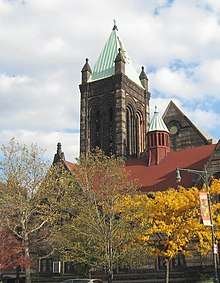
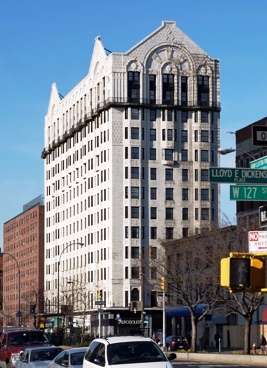

Many places in Harlem are New York City Landmarks, listed on the National Register of Historic Places, or are otherwise prominent:
- 155th Street Viaduct leading to Macombs Dam Bridge
- Abyssinian Baptist Church
- Adam Clayton Powell Jr. State Office Building
- All Saints Church
- Apollo Theater
- Atlah Worldwide Church
- Schomburg Center for Research in Black Culture
- Astor Row
- Blockhouse[62]
- Bushman Steps Stairway that led baseball fans from the subway to The Polo Grounds ticket booth.[62][63]
- City College of New York
- Cotton Club
- Duke Ellington Circle
- Dunbar Apartments designed by architect Andrew J. Thomas. former home to W. E. B. Du Bois, Paul Robeson, Asa Philip Randolph, Bill “Bojangles” Robinson and explorer Matthew Henson[62]
- First Corinthian Baptist Church
- Fort Clinton, Central Park and Nutter's Battery
- Frederick Douglass Circle
- Graham Court
- Hamilton Grange
- Hamilton Heights
- Harbor Conservatory for the Performing Arts
- Harlem Children's Zone
- Harlem Hospital Center
- Harlem River Houses
- The Harlem School of the Arts
- Harlem Stage
- Harlem YMCA
- Harlem Hellfighters Monument / 369th Infantry Regiment Memorial[62]
- Hooper Fountain[62]
- Hotel Theresa
- James Bailey House
- Jumel Terrace and Morris-Jumel Mansion in modern-day Washington Heights.
- Langston Hughes House
- La Marqueta
- Lenox Lounge
- Manhattan Avenue-West 120th-123rd Streets Historic District
- Mink Building
- Minton's Playhouse
- Morningside Park
- Mount Morris Bank Building
- Mount Morris Park Historic District
- Icahn School of Medicine at Mount Sinai and Mount Sinai Hospital, New York
- El Museo Del Barrio
- Museum of the City of New York
- National Black Theater
- New York College of Podiatric Medicine
- Rucker Park
- St. Martin's Episcopal Church (formerly Trinity Church) designed by William Appleton Potter[64]
- Savoy Ballroom marked by a plaque on Lenox.[65]
- St. Nicholas Historic District
- St. Nicholas Houses
- Strivers' Row
- Studio Museum in Harlem
- Swing Low Harriet Tubman Memorial
- Sylvia's Soul Food
- West 147th-149th Streets Historic District
Population and demographics
Like most neighborhoods in New York, the demographics of Harlem's communities have changed rapidly throughout the history of New York.
In 1910, 10% of Harlem's population was black but by 1930, they had become a 70% majority.[7] The period between 1910 and 1930 marks a huge point in the great migration of African Americans from the South to New York. This point also marks an influx from downtown Manhattan neighborhoods where blacks were feeling less welcome, to the Harlem area.[7] The black population in Harlem peaked in 1950 with a 98% share of the population (population 233,000).
As of 2000, Central Harlem had a black community comprising 77% of the population; however, the black population is declining as many African Americans moved out as more and more immigrants began to move in.[66] Central Harlem is the most famous section of Harlem and thus is commonly referred to simply as Harlem. Central Harlem is home to the famous Apollo Theater.
Central Harlem
In 2010, the population of Central Harlem was at 115,000 according to a regional census.[67] Central Harlem is home to the Mount Morris Park neighborhood.
West Harlem
In 2010, the population of West Harlem was at 110,193 according to a regional census.[68]
West Harlem, consisting of Manhattanville and Hamilton Heights, as a whole is predominately Hispanic. African Americans make up about a quarter of the West Harlem population.[3]
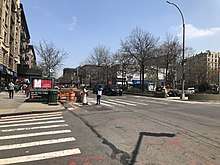
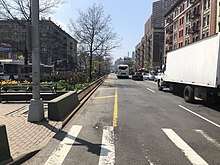
East Harlem
In 2010, the population of East Harlem was at 120,000.[69]
East Harlem originally formed as a predominantly Italian American neighborhood, but its demographics have changed over the years. and it is now known as a predominantly Hispanic neighborhood. Italian Harlem formed when Southern Italian immigration began in the late 19th century.[70] Italian Harlem is notable as the founding location of the Genovese crime family, one of the Five Families that dominated Italian organized crime in New York City as part of the Mafia (or Cosa Nostra).[71]
The area began its transition from Italian Harlem to Spanish Harlem when Puerto Rican migration began after World War II.[72] This community of stateside Puerto Ricans is notable for its contributions to Salsa music. In recent decades, many Mexican and Salvadorean immigrants have also settled in East Harlem.[73] East Harlem is also known as El Barrio (literally translated, "The Neighborhood") and today is predominantly Hispanic, though with a significant Black presence.[72] The area suffers from the highest violent crime rate in Manhattan.[74]
Social issues
Poverty and health
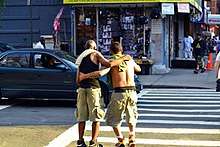
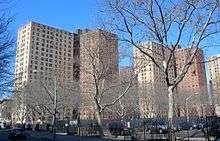
Harlem suffers from unemployment rates generally more than twice as high than the New York average[75] and high mortality rates as well. In both cases, the numbers for men have been consistently worse than the numbers for women. Unemployment and poverty in the neighborhood resisted private and governmental initiatives to ameliorate them. During the Great Depression, unemployment in Harlem went past 20% and people were being evicted from their homes.[76] In the 1960s, uneducated blacks could find jobs more easily than educated ones could, confounding efforts to improve the lives of people who lived in the neighborhood through education.[77] Land owners took advantage of the neighborhood and offered apartments to the lower-class families for cheaper rent but in lower-class conditions.[78] As of 1999, 179,000 housing units were available for the citizens of Harlem.[79] Housing activists in Harlem state that, even after residents were given vouchers for the Section 8 housing that was being placed, many were not able to live there and had to find homes elsewhere or become homeless.[79] Infant mortality was 124 per thousand in 1928 (12.4%) .[80] By 1940, infant mortality in Harlem was 5% (one infant in 20 would die), and the death rate from disease generally was twice that of the rest of New York. Tuberculosis was the main killer, and four times as prevalent among Harlem citizens than among the rest of New York's population.[80]
A 1990 study of life expectancy of teenagers in Harlem reported that 15-year-old girls in Harlem had a 65% chance of surviving to age 65, about the same as women in Pakistan. Fifteen-year-old men in Harlem, on the other hand, had a 37% chance of surviving to age 65, about the same as men in Angola; for men, the survival rate beyond the age of 40 was lower in Harlem than Bangladesh.[81] Infectious diseases and diseases of the circulatory system were to blame, with a variety of contributing factors, including consumption of the deep-fried foods traditional to the South, which may contribute to heart disease.
Crime
In the early 20th century, Harlem was a stronghold of the Italian Mafia. As the ethnic composition of the neighborhood changed, black criminals began to organize themselves similarly. However, rather than compete with the established mobs, gangs concentrated on the "policy racket", also called the numbers game, or bolita in East Harlem. This was a gambling scheme similar to a lottery that could be played, illegally, from countless locations around Harlem. According to Francis Ianni, "By 1925 there were thirty black policy banks in Harlem, several of them large enough to collect bets in an area of twenty city blocks and across three or four avenues."[82]
By the early 1950s, the total money at play amounted to billions of dollars, and the police force had been thoroughly corrupted by bribes from numbers bosses.[83] These bosses became financial powerhouses, providing capital for loans for those who could not qualify for them from traditional financial institutions, and investing in legitimate businesses and real estate. One of the powerful early numbers bosses was a woman, Madame Stephanie St. Clair, who fought gun battles with mobster Dutch Schultz over control of the lucrative trade.[84]
The popularity of playing the numbers waned with the introduction of the state lottery, which is legal but has lower payouts and has taxes collected on winnings.[85] The practice continues on a smaller scale among those who prefer the numbers tradition or who prefer to trust their local numbers bank to the state.
Statistics from 1940 show about 100 murders per year in Harlem, "but rape is very rare".[86] By 1950, essentially all of the whites had left Harlem and by 1960, much of the black middle class had departed. At the same time, control of organized crime shifted from Italian syndicates to local black, Puerto Rican, and Cuban groups that were somewhat less formally organized.[82] At the time of the 1964 riots, the drug addiction rate in Harlem was ten times higher than the New York City average, and twelve times higher than the United States as a whole. Of the 30,000 drug addicts then estimated to live in New York City, 15,000 to 20,000 lived in Harlem. Property crime was pervasive, and the murder rate was six times higher than New York's average. Half of the children in Harlem grew up with one parent, or none, and lack of supervision contributed to juvenile delinquency; between 1953 and 1962, the crime rate among young people increased throughout New York City, but was consistently 50% higher in Harlem than in New York City as a whole.[87]
Injecting heroin grew in popularity in Harlem through the 1950s and 1960s, though the use of this drug then leveled off. In the 1980s, use of crack cocaine became widespread, which produced collateral crime as addicts stole to finance their purchasing of additional drugs, and as dealers fought for the right to sell in particular regions, or over deals gone bad.[88]
With the end of the "crack wars" in the mid-1990s and with the initiation of aggressive policing under mayors David Dinkins and subsequently Rudolph Giuliani, crime in Harlem plummeted. In 1981, 6,500 robberies were reported in Harlem; robberies dropped to 4,800 in 1990 during David Dinkins' mayoralty. By 2000, only 1,700 robberies were reported, and by 2010, only 1,100 were reported. There have been similar changes in all categories of crimes tracked by the New York City Police Department.[89] In the 32nd Precinct, which services Central Harlem above 127th Street, for example, between 1990 and 2013, the murder rate dropped 89.4%, the rape rate dropped 67.5%, the robbery rate dropped 74.2%, burglary dropped 93.4%, and the total number of crime complaints dropped 77.6%.[90]
Education
In 1977, Isiah Robinson, president of the New York City Board of Education, was quoted as saying that "the quality of education in Harlem has degenerated to the level of a custodial service."[45] Currently the New York City Department of Education operates district public schools.
As of May 2006, Harlem was the heart of the charter schools movement in Manhattan; of the 25 charter schools operating in Manhattan, 18 were in Harlem.[91] In 2010, approximately one age-eligible Harlem child in five was enrolled in charter schools.[92]
The New York Public Library operates the Harlem Branch Library at 9 West 124th Street,[93] the George Bruce Library at 518 West 125th Street,[94] the 115th Street Branch Library at 203 West 115th Street,[95] and the 125th Street Branch Library at 224 East 125th Street, near Third Avenue.[96]
The CUNY Graduate School of Public Health and Health Policy, New York College of Podiatric Medicine, City College of New York, and Touro College of Osteopathic Medicine, in addition to a branch of College of New Rochelle, are all located in Harlem.
Transportation
Bridges
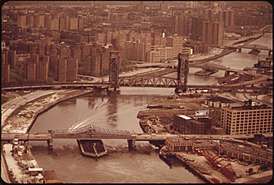
The Harlem River separates the Bronx and Manhattan, necessitating several spans between the two New York City boroughs. In East Harlem, the Wards Island Bridge, also known as the 103rd Street Footbridge, connects Manhattan with Wards Island. The Triboro Bridge is a complex of three separate bridges that offers connections between Queens, Manhattan (Harlem), and the Bronx.[97]
Public transportation

Public transportation service is provided by the Metropolitan Transportation Authority. This includes the New York City Subway and MTA Regional Bus Operations, as well as a Metro-North commuter rail stop at East 125th Street, connecting Westchester County with New York City. Some Bronx local routes also serve Manhattan, to provide customers with access between both boroughs.[98]
Subway routes include:
- IRT Lenox Avenue Line (2 and 3 trains)[99]
- IRT Broadway–Seventh Avenue Line (1 train)[99]
- IRT Lexington Avenue Line (4, 5, 6, and <6> trains at 125th Street)[99]
- IND Eighth Avenue Line (A, B, C, and D trains)[99]
- IND Concourse Line (B and D trains at 155th Street)[99]
- Future: IND Second Avenue Line[100]
Bus routes include:
SoHa controversy
"SoHa" is a controversial sobriquet some real estate professionals and others interested in gentrifying the neighborhood are applying to the section of South Harlem spanning West 110th to West 125th Streets, in an effort to rebrand the neighborhood. [102][103][104] Residents and other critics seeking to prevent this renaming of that culturally rich, historic area have labelled the SoHa brand as "insulting and another sign of gentrification run amok"[105] and have pointed out, "the rebranding not only places their neighborhood’s rich history under erasure but also appears to be intent on attracting new tenants, including students from nearby Columbia University."[106]
Multiple New York City politicians have initiated legislative efforts to curtail this practice of neighborhood rebranding, which when successfully introduced in other New York City neighborhoods, over the past 50 years, leading to increases in rents and real estate values, as well as "shifting demographics":[106]
- In 2011, the U.S. House of Representatives Assemblyman Hakeem Jeffries attempted but failed to implement legislation "that would punish real estate agents for inventing false neighborhoods and redrawing neighborhood boundaries without city approval."[106]
- New York State Senator Brian Benjamin is currently working to render illegal the practice of rebranding historically recognized neighborhoods. For example:[106]
Earlier this year [2017], he introduced the Neighborhood Integrity Act, which seeks to create “a formal process for renaming or re-designating a traditionally recognized neighborhood in the city of New York” and “provides penalties for real estate brokers and agents who advertise a property as part of, or located in, a designated neighborhood that is not traditionally recognized as such.” Notably, Senator Benjamin’s proposed act is clear about who is to blame for the growing push to rename New York City neighborhoods: “Realtors have increasingly resorted to a practice of renaming neighborhoods and redrawing traditional neighborhood boundaries in order to rebrand an area as more desirable for affluent New Yorkers. These actions are not without consequence.”
See also
- List of films shot in Harlem
- List of people from Harlem


References
- ↑ "Harlem neighborhood in New York". Retrieved December 16, 2010.
- 1 2 "Manhattan CD 10 Profile" (PDF). Archived from the original (PDF) on August 25, 2014. Retrieved 2014-05-28.
- 1 2 3 "Manhattan CD 9 Profile" (PDF). Archived from the original (PDF) on September 28, 2013. Retrieved 2014-05-28.
- 1 2 "Manhattan CD 11 Profile" (PDF). Archived from the original (PDF) on September 28, 2013. Retrieved 2014-05-28.
- ↑ Pierce, Carl Horton, et al. New Harlem Past and Present: the Story of an Amazing Civic Wrong, Now at Last to be Righted. New York: New Harlem Pub. Co., 1903.
- ↑ "Harlem History |". Harlemworldmag.com. January 26, 1934. Archived from the original on December 13, 2012. Retrieved February 2, 2013.
- 1 2 3 4 Roberts, Sam (January 5, 2010). "No Longer Majority Black, Harlem Is in Transition". The New York Times. Retrieved October 2, 2016.
- ↑ "Harlem Community District Profile". nyc.gov.
- ↑ Fraser, Lisa (March 13, 2013). "South Harlem: An old city neighborhood developing a new style". amNY. Archived from the original on January 4, 2014.
- ↑ Arieff, Irwin (December 24, 2009). "Momentum in South Harlem". The New York Times.
- ↑ "New York City Police Department". www.nyc.gov.
- ↑ 26th Precinct, New York City Police Department.
- ↑ 28th Precinct, New York City Police Department.
- ↑ 32nd Precinct New York City Police Department.
- ↑ 23rd Precinct, New York City Police Department.
- ↑ 25th Precinct, New York City Police Department.
- ↑ Ellis, Edward Robb (1966). The Epic of New York City. Old Town Books. p. 52.
- ↑ Gill, 2011, p. 6
- ↑ Riker, James (1904), Harlem: Its Origins and Early Annals, Elizabeth, New Jersey: New Harlem Publishing Company
- ↑ "Harlem in the Old Times" (PDF). The New York Times. January 11, 1880. Retrieved December 30, 2012.
- ↑ Gill, 2011, p. 61.
- ↑ "Harlem, the Village That Became a Ghetto", Martin Duberman, in New York, N.Y.: An American Heritage History of the Nation's Greatest City, 1968
- ↑ Gill, 2011, pp. 100, 109.
- ↑ Gill, 2011, p. 86.
- ↑ "The Growth and Decline of Harlem's Housing", Thorin Tritter, Afro-Americans in New York Life and History, January 31, 1998
- ↑ Gill, 2011, pp. 175, 210.
- ↑ "The Making of Harlem" Archived June 15, 2006, at the Wayback Machine., James Weldon Johnson, The Survey Graphic, March 1925
- ↑ Gotham Gazette, 2008 Archived January 17, 2012, at the Wayback Machine.
- ↑ "118,000 Negroes Move From The South", The New York World, November 5, 1917
- 1 2 3 "Harlem's Shifting Population". Gotham Gazette. The Citizens Union Foundation. August 27, 2008. Archived from the original on February 12, 2010. Retrieved June 9, 2011.
- ↑ "Harlem Stirs", 1966, p. 27.
- ↑ "A Landmark Struggle", Lisa Davis, Preservation Online, November 21, 2003 Archived February 4, 2008, at the Wayback Machine.
- ↑ East Harlem's History, New Directions: A 197-A Plan for Manhattan Community district 11 (Revised 1999)
- ↑ Pinkney & Woock, Poverty and Politics in Harlem (1970), p. 33.
- ↑ "Harlem Stirs", 1966, p. 104.
- ↑ "Harlem Losing Ground as Negro Area", New York Herald Tribune, April 6, 1952
- ↑ Powell, Michael. "Harlem's New Rush: Booming Real Estate" Archived April 10, 2005, at the Wayback Machine., The Washington Post, March 13, 2005. Accessed May 18, 2007. "The transformation of this historic capital of Black America has taken an amphetamined step or three beyond a Starbucks, a Body Shop and former president Bill Clinton taking an office on 125th Street."
- ↑ Brooks, Charles. "Harlemworld: Doing Race and Class in Contemporary Black America – nonfiction reviews – book review", Black Issues Book Review, March–April 2002. Accessed May 18, 2007. "There's a mystique that surrounds Harlem --with its rich historical tradition, literature, music, dance, politics and social activism. Consequently, Harlem is referred to as the "Black Mecca" the capital of black America, and arguably the most recognized black community in the country."
- ↑ "Harlem's Dreams Have Died in Last Decade, Leaders Say", The New York Times, March 1, 1978, p. A1.
- ↑ Stern, Fishman & Tilove, New York 2000 (2006), p. 1016
- 1 2 "Census trends: Young, white Harlem newcomers aren't always welcomed", New York Daily News, December 26, 2010
- ↑ Stern, Fishman & Tilove, New York 2000 (2006), p. 1013.
- ↑ "New boy in the 'hood'", The Observer, August 5, 2001 Archived February 27, 2007, at the Wayback Machine.
- ↑ The Economic Redevelopment of Harlem, PhD Thesis of Eldad Gothelf, submitted to Columbia University in May 2004
- 1 2 "To Live in Harlem", Frank Hercules, National Geographic, February 1977, p.178+
- ↑ Jim Williams, "Need for Harlem Theater", in Harlem: A Community in Transition, 1964. p.158
- ↑ Pfeffer, Murray L. "My Harlem Reverie". The Big Bands Database. Archived from the original on March 31, 2010. Retrieved October 2, 2016.
- ↑ Freeland, David (2009). Automats, Taxi Dances, and Vaudeville: Excavating Manhattan's Lost Places of Leisure. NYU Press. p. 155. ISBN 978-0-8147-2763-8.
- ↑ "Saxman Finds Place For Jazz History" (Video). New York City News Service. December 18, 2008. Retrieved December 6, 2013.
- ↑ "Jam Streets as 'Macbeth' Opens", The New York Times, April 15, 1936
- ↑ "Gatehouse Ushers in a Second Act as a Theater", The New York Times, October 17, 2006
- ↑ Otterman, Sharon (December 22, 2009). "A Quiet End for Boys Choir of Harlem". The New York Times. Retrieved 18 February 2015.
- ↑ Kennedy, Randy (November 24, 1997). "A Girls' Choir Finally Sings In Spotlight". The New York Times. Retrieved 18 February 2015.
- ↑ "HISTORY OF AFRICAN AMERICAN DAY PARADE, INC". African American Day Parade. Archived from the original on February 18, 2015. Retrieved February 18, 2015.
- ↑ "Drone Footage Shows Hurricane Lane Flooding in Hawaii". NBC New York.
- ↑ Mays, Jeff (October 18, 2013). "Harlem Residents Hold Sit-In to Protest Farmers Market Takeover of Plaza". DNAinfo.com. Archived from the original on November 23, 2013.
- ↑ Scott, William B.; Rutkoff, Peter M. (August 14, 2001). "New York Modern: The Arts and the City". JHU Press – via Google Books.
- ↑ Valerio, John (August 1, 2016). "How to Play Solo Jazz Piano". Hal Leonard Corporation – via Google Books.
- ↑ "The New Heyday of Harlem", Tessa Souter, The Independent, Sunday, June 8, 1997
- ↑ Fact Not Fiction in Harlem, John H. Johnson, St. Martin's Church, 1980. p. 69+
- ↑ Harlem U.S.A., ed. John Henrik Clarke, introduction to 1971 edition
- 1 2 3 4 5 Landmarks and History of Upper Manhattan Archived August 10, 2013, at the Wayback Machine.
- ↑ "Bushman Steps NYC Parks website highlights".
- ↑ Bells of St Martin by Kathleen Hulse
- ↑ Savoy Ballroom Marker Archived August 10, 2013, at the Wayback Machine.
- ↑ Nyc.gov Archived March 17, 2013, at the Wayback Machine.
- ↑ "Manhattan Community District 10 - New York City Department of City Planning". Nyc.gov. Retrieved 2014-05-28.
- ↑ "Nyc.gov West Harlem Community District Profil".
- ↑ "Nyc.org Harlem Manhattan Community District Profile".
- ↑ Nycteachingfellows.org Archived August 24, 2014, at the Wayback Machine.
- ↑ "Genovese Crime Family-One of the "Five Families"". American Mafia History. 2012-05-06. Retrieved 2012-09-19.
- 1 2 "El Barrio (Spanish Harlem) New York City.com : Visitor Guide : Editorial Review". Nyc.com. Retrieved 2013-02-02.
- ↑ "East Harlem". studio323ny.com. Archived from the original on August 17, 2012. Retrieved 2013-02-02.
- ↑ "What a Safer City Really Looks Like" (PDF). Retrieved 2012-09-19.
- ↑ Poverty and Politics in Harlem, Alphnso Pinkney & Roger Woock, College & University Press Services, Inc., 1970, p.31
- ↑ Taylor, Nick. "The Great Depression." Great Depression (1930's) News. N.p., n.d. Web. 02 Oct. 2013.
- ↑ The Economic Development of Harlem, Thomas Vietorisz and Bennett Harrison, Praeger Special Studies in U.S. Economic and Social Development, 1970, p.19
- ↑ "Harlem." Encyclopedia of Urban America: the cities and Suburbs. Santa Barbara. ABC-CLIO, 1998. Credo Reference. Web. 02 Oct. 2013.
- 1 2 Hyra, Derek S. The New Urban Renewal: The Economic Transformation of Harlem and Bronzeville. Chicago: University of Chicago, 2008. 103. Print.
- 1 2 "Congestion Causes High Mortality", The New York Times, October 24, 1929
- ↑ McCord, C.; Freeman, H. P. (1990). "Excess Mortality in Harlem". New England Journal of Medicine. 322 (3): 173–177. doi:10.1056/NEJM199001183220306.
- 1 2 Francis A.J. Ianni, Black Mafia, 1974
- ↑ "Inside Story of Numbers Racket", Amsterdam News, August 21, 1954
- ↑ Cook, Fred J. "The Black Mafia Moves Into the Numbers Racket", The New York Times, April 4, 1971. Accessed December 28, 2016. "In those days, Madame Stephanie St. Clair became known as the “Policy Queen” of Harlem.... Once Dutch Schultz dis covered this potential gold mine, he moved in, gang guns blazing. Madame St. Claire, who survived to become a big property owner and business woman in Harlem, fought Schultz from 1931 to 1935."
- ↑ Wilson, Michael. "Relics of the Bygone (and the Illegal)", The New York Times, March 22, 2013. Accessed December 28, 2016. "Several years later, with the state lottery offering a similar game, runners and numbers bankers openly protested in Manhattan. They feared the legal game would wipe out the rackets and their jobs. They were, for the most part, right.... The few numbers joints that survive do so in part because the payouts are often better than the lottery, the police said."
- ↑ "244,000 Native Sons", Look Magazine, May 21, 1940, p.8+
- ↑ Poverty and Politics in Harlem, Alphonso Pinkney & Roger Woock, College & University Press Services, Inc., 1970, p.33
- ↑ "Harlem Speaks: A Living History of the Harlem Renaissance." Wintz, Cary.
- ↑ "How New York Cut Crime", Reform Magazine, Autumn 2002 p.11 Archived March 8, 2008, at the Wayback Machine.
- ↑ "Compstat – Volume 16 No.4 – 32nd Precinct" (PDF). NYPD Compstat unit. October 26, 2014. Archived from the original (PDF) on 2010-08-13. Retrieved November 5, 2014.
- ↑ "New York Charter Schools Association". Archived from the original on May 5, 2006. Retrieved May 14, 2006.
- ↑ The Teachers' Unions' Last Stand, by Steven Brill (Single Page online URL), in The New York Times, in the Magazine, Sunday, May 23, 2010, p. MM32 (print version may differ), as accessed June 10, 2010.
- ↑ "Harlem Branch Library". New York Public Library. Retrieved on January 30, 2009.
- ↑ "George Bruce Library". New York Public Library. Retrieved on January 20, 2015.
- ↑ "115th Street Branch Library". New York Public Library. Retrieved on January 30, 2009.
- ↑ "125th Street Branch Library". New York Public Library. Retrieved on January 30, 2009.
- ↑ "Robert F. Kennedy Bridge". Mta.info. December 30, 2010. Archived from the original on January 21, 2013. Retrieved February 2, 2013.
- ↑ "MTA New York City Transit". Mta.info. Retrieved February 2, 2013.
- 1 2 3 4 5 "Subway Map" (PDF). Metropolitan Transportation Authority. January 18, 2018. Retrieved January 18, 2018.
- ↑ Mta.info—Second Avenue Subway map Archived April 8, 2014, at the Wayback Machine.
- 1 2 "Manhattan Bus Map" (PDF). Metropolitan Transportation Authority. December 2017. Retrieved April 24, 2018.
- ↑ "SoHa in Harlem? The Misguided Madness of Neighborhood Rebranding". The New York Times. July 6, 2017.
- ↑ "'SoHa' Is a Renaissance Few in Harlem Want". The Wall Street Journal. July 1, 2017.
- ↑ "'SoHa' Rebranding Effort In South Harlem Stirs Outrage". CBS New York. June 26, 2017.
- ↑ "Attempt to Rebrand Harlem as 'SoHa' Leaves Residents Fuming". US News Company. NEW YORK. AP. May 25, 2017.
- 1 2 3 4 Etherington, Cait (July 10, 2017). "From NoLiTa to SoHa: The practice and controversy of rebranding NYC neighborhoods". 6sqft.com.
Further reading
- Gill, Jonatham, Harlem: The Four Hundred Year History from Dutch Village to Capital of Black America, Grove Press, 2011.
- Ianni, Francis A. J. Black Mafia: Ethnic Succession in Organized Crime, 1974.
- King, Shannon. Whose Harlem Is This? Community Politics and Grassroots Activism During the New Negro Era. New York: New York University Press, 2015.
- Osofsky, Gilbert. Harlem: The Making of a Ghetto: Negro New York, 1890–1930, 1971.
- WPA Guide to New York City, 1939
- TIME, vol. 84, No. 5, July 31, 1964. "Harlem: No Place Like Home".
- Newsweek, August 3, 1964. "Harlem: Hatred in the Streets".
- Harlem Stirs, John O. Killens, Fred Halstead, 1966.
- "Crack's Decline: Some Surprises from U.S. Cities", National Institute of Justice Research in Brief, July 1997.
- Bourgois, Philippe. In search of respect: Selling crack in El Barrio. Vol. 10. Cambridge University Press, 2003.
External links
| Wikivoyage has a travel guide for Harlem and Upper Manhattan. |
| Wikimedia Commons has media related to Harlem, Manhattan. |

